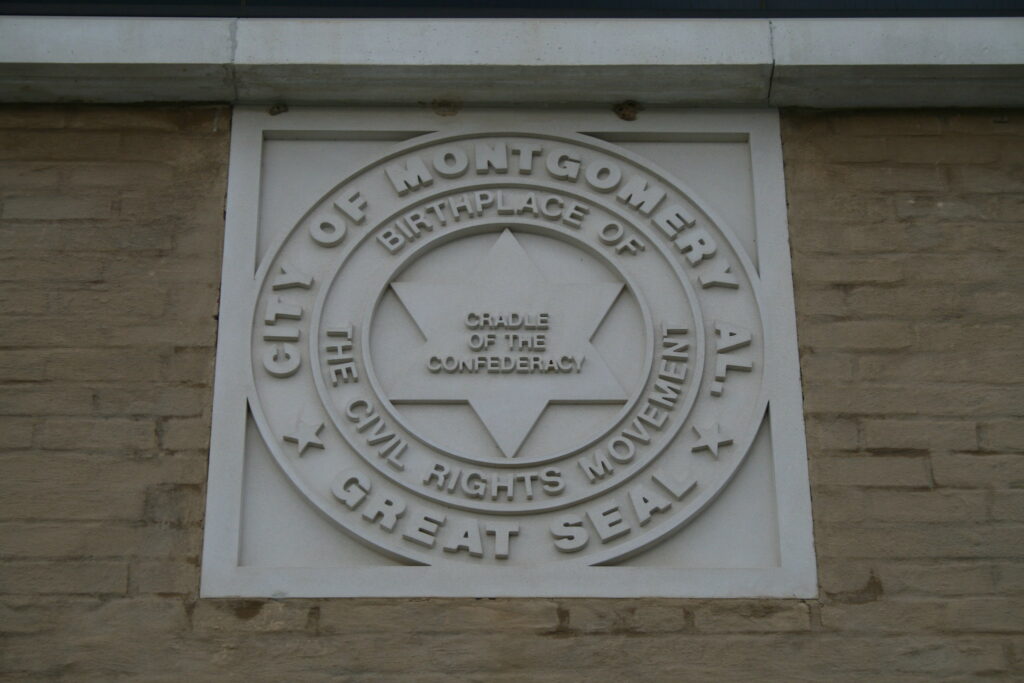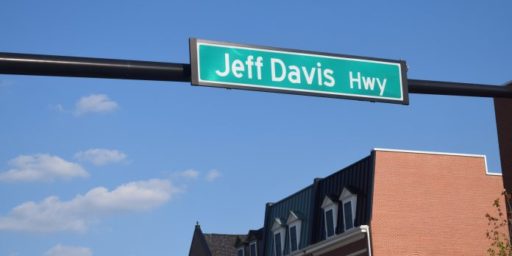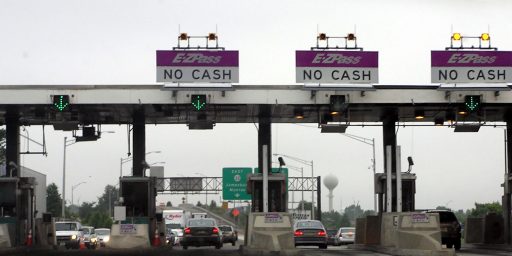Racial Impacts of the Interstate in Montgomery, AL
Another example for the conversation.

James Joyner’s post about Pete Buttigieg’s comments about the racial implications of infrastructure choices in the past made we think of this 2018 story from the Montgomery Advertiser, Cleaved by Concrete: The legacy of Montgomery’s interstates and the neighborhoods they destroyed.
interstates 65 and 85 were primarily built through majority black communities, small inner-city towns born out of segregation and built by African-Americans shut out of other parts of Montgomery.
[…]
Approximately 75 percent of the families impacted by the construction of I-65 were black, according to Alabama State University archivist Howard Robinson, who studied the construction of interstates while researching his dissertation on Montgomery’s desegregation.
[…]
There I-85 barreled through an estimated 356 homes in Centennial Hill, Bel Air and The Bottoms, according to a 1960 Highway Department memo. All three were predominantly black neighborhoods, and 192 of the houses along that stretch — more than half of the residences affected — were designated as “poor condition. The state estimated an average payment of $3,300 per house, a price the poor and elderly felt didn’t cover the loss.
“Since these people were poor and black, housing was scarce in Montgomery. They were essentially left homeless,” Bailey said.
One can still see the disruption of those areas of the city today–all of which was exacerbated by white flight from the city’s core (made easier, it is worth noting, by the presence of the new interstates).
Regardless, given what we know about how homeownership and small businesses are ways to build intergenerational wealth, disruptions like those noted above should be obvious in their impact. And even those whose homes were not destroyed, rather obviously the values of homes in neighborhood nows right by the interstate plummeted.
There is also the fact that where were the displaced to go in the segregated south? It wasn’t like they have a panoply of options.
As the articles notes, this was a pattern nationwide:
Montgomery’s black neighborhoods weren’t the only ones to face the cuts of concrete. Across America, multilane roads stabbed through poor and minority neighborhoods after the passage of the Federal-Aid Highway Act in 1956.
In Miami, construction of Interstate 95 wiped out 10,000 homes and a black business district. Interstate 40 in Nashville destroyed 80 percent of black businesses in the city and 650 homes. In St. Paul, I-94 crushed the bustling black Rondo neighborhood and displaced nearly 3,000 families.
The piece notes that all of this was happening in Montgomery during a time that agitation for civil rights was underway in the city (for example, Rosa Parks refused to give up her seat on the bus in 1955, sparking the Montgomery Bus Boycott that ran from 1955 to 1956). The Federal Highway Act that that would fund the interstates in question passed in 1956, setting the stage for the following:
The same year the federal highways bill passed, British magazine Picture Post referred to Montgomery as a “crisis centre” and quoted “spokesman of segregation” Sam Engelhardt, an Alabama senator from Shorter and a leader of the segregationist White Citizens Council.
As senator, Engelhardt infamously gerrymandered Tuskegee city limits into a 28-sided figure that removed 99 percent of African-Americans. In 1958, Engelhardt ran for lieutenant governor on the campaign slogan “segregation every day in every way.” In 1959, he was named director of the State Highway Department.
“Never before or after has that much federal cash flowed into the state of Alabama,” said Neil. “He essentially weaponized a public infrastructure project with the intention of destroying a civil rights incubator.”
After the 1960 public hearing in Montgomery, neighborhood residents led by the Rev. George Curry staged a national opposition campaign that helped delay construction of I-85 through their neighborhoods for six or seven years.
“It was interesting, because black people did not have local political influence, but they had national political influence so you saw many of the local folks appealing to national folks who then intervened in what was happening,” Robinson said.
And it isn’t like this is all ex post facto reasoning. The community at the time was aware of the impact of the planned highways:
Abernathy wrote a telegram to President John F. Kennedy about the interstate in 1961. The Washington, D.C., bureau of the NAACP wrote the secretary of commerce. Curry had submitted both a petition of 1,150 signatures and an alternate route proposal eight days after the meeting. He also contacted Engelhardt and eventually the federal Bureau of Public Roads (BPR).
“Rev. Curry alleges that the routing of this highway will uproot a Negro community, which has no place to relocate, and two Negro churches,” an archived BPR memo reads. “It is claimed that there is a nearby alternate route which would cost $30,000 less. Rev. Curry charges that the proposed routing of the highway is designed by state and local officials to purposely dislodge this Negro community where many of the leaders of the fight for desegregation in Montgomery reside. Rev. Curry said that in a recent conversation with a Mr. Sam Engelhardt, Alabama’s Highway Director, Mr. Engelhardt stated that it was his intention to get Rev. Abernathy’s church.”
Granted, proving racial intent is not easy:
University of California Irvine professor Joe DiMento has studied the motivations and effects of interstate construction nationwide, focusing on Los Angeles, Memphis and his hometown of Syracuse in his book “Changing Lanes: Visions and Histories of Urban Freeways.”
Interstate 81 unequivocally crushed black and Jewish neighborhoods in Syracuse, but ascertaining malicious racial intent is not as clear-cut, DiMento said.
“In Syracuse, my very in-depth analysis did not indicate racial motivation,” DiMento said. “It doesn’t mean it wasn’t there. There is a very difficult challenge sorting out what was motivating decision-makers.”
Similarly, Robinson said, “I don’t see any evidence of specifically targeting black communities to remove black people from the downtown areas” in Montgomery.
“Nor do you see, like I-20 was supposed to be the demarcation between black and white Atlanta, I don’t see evidence of that,” Robinson said.
But, I would note, if proving intent is hard (but it is hard to know anything about Alabama state politics in the later 1950s/early 1960s and not see racism as, at best, part of the ethos) proving impact on Black communities is pretty easy (as some of the above notes).
And while the argument was that it was about future traffic flows, I would note that the flow noted were where the white population would migrate over the next several decades:
The official explanation from the Highway Department pointed to traffic analysis and planned growth of the city as key factors in determining I-85’s path, according to minutes from the meetings.
“The future desire line indicates a heavy traffic growth to the southeast and to the east in Montgomery,” Highway Department design engineer W.F. Land told the 650 crowding City Hall at the 1960 meeting. “This location that we have at this Interstate route 85 will fit in between these two projected traffic bands and relieve these congested city streets.”
The east and southeast of Montgomery are the wealthier parts to this day (with a pattern that I have even seen over two decades living here of a constant creep further eastward–or to suburbs to the north).
Montgomery today is a city that seemingly lacks a unified identity. Its split personality — cradle of the Confederacy, birthplace of the civil rights movement — is emblazoned on its seal and physically manifested by the highways.
Interstate 65 runs from the southernmost point of Lake Michigan to Mobile Bay, separating Montgomery’s “west side” minority communities from the rest of the city as it passes through Alabama’s capital. Intentionally or not, the interchange divides and impedes the growth of surrounding neighborhoods.
“You create these fragmentary corners of what was intact city grid,” Neil said. “There’s places like this in west Montgomery where there’s one road in under the highway and there’s a neighborhood back there. Those neighborhoods tend to experience much higher instances of poverty, crime and poor health outcomes than other places in the city grid. Those traps are exactly what they say they are.”
Ask locals what the center of town is, and you will get a variety of answers: the Cloverdale neighborhood, the shopping centers out east, downtown Montgomery.
But the same downtown that houses the state Legislature and more museums than bars is also one of the poorest districts in the city, enclosed to the south and west by the interstates and the poor, blighted neighborhoods they run through.
In some ways, the interstate is the center of town.
I will say that some efforts have been made to revitalize downtown, with some success. But you can plainly see the legacy of white flight all throughout that part of Montgomery.
The piece is lengthy and I commend anyone interested to read the whole thing.
Do I have some elegant policy fix for all of this? I do not. But I will say this: if we refuse to understand the way the past shaped the present, we will continue to ignore how it shapes the future.
I would also note that our collective desire to want to ignore the impact of these actions just helps to fuel the narrative that Blacks and other minorities are lazy and inferior to whites. Consider how many people would readily assert that Black Montgomerians who live near I-85 must have chosen to live in a run-down part of town of their own volition with no acknowledgment that they congregated there in the first place due to segregation and various public policy choices only to have that neighborhood significantly impacted by the construction of two interstates. And where one lives impacts things like schools and, again, the ability to build intergenerational wealth and any number of factors.
Just saying “let the past be the past” ignores the ways in which that past has led to life outcomes for a lot of our citizens, as well as helping feed narratives of racial superiority and inferiority. These are not trivial matters.






But, but. It’s time to move on. (It’s always time to move on.)
Speaking of moving on, does the seal of the City of Montgomery really say “Birthplace of the Civil Rights Movement” and “Cradle of the Confederacy”?
One thing I learned from my time in the Golden Horde is that at the roots of all racist/segregationist/bigoted behavior is an economic/political interest. I’m sure there’s one here, too.
There aren’t a huge amount of black people in my life, but what ones there are enrich it. Probably more so than the average white person in my life. I don’t know why I would want to erect barriers to there being more of them.
But I do know why Englehardt would. Those black people wanted to mess up the reigning order, of which he was high on the heap. As far as he was concerned, they must be stopped. But as far as I am concerned, they were gonna mess things up in exactly the right way.
That kind of guy did nothing at all for me, other than threaten me with the label “n****r-lover”. But they made that really scary, and with real-world consequences. That’s how they maintained their grip, a grip which I would be happy to tear down.
=========
I lay this all out, because it is an example of an affirmation of integrationism and better race relations as politics that doesn’t engage in guilt. My interests are, in fact, aligned with those of black voters. I think that this is a valuable addition, if not replacement, to the constant smashing of the ‘guilt’ button.
@gVOR08:
They should change the city’s name to Irony, AL, right?
And what’s with the Star of David dead center?
Austin is such a good example of this. As you may recall from your time there, I-35 was intentionally placed to separate East Austin from the rest of the city core. And the continued lack of a unified loop around the city makes it difficult for folks from East Austin to get to places like West Lake Hills and Barton Creek.
As noted in the article, when the interstate went through Nashville it completely disrupted the black community which was located on the northwest side of downtown Nashville. The routing which avoided the more well off white neighborhoods resulted in a constant traffic jam in the downtown area. In order to relieve the traffic problem an outer loop (I-440) was proposed which happened to go through the more affluent, mostly white neighborhoods. As can be imagined there was an uproar from the affected neighborhoods claiming disruption of the community. A lawsuit was filed which landed on the bench of District Judge L. Clure Morton who had just recently desegregated the Nashville schools with a busing order. Judge Morton was having none of it and dismissed the case. I-440 was then completed.
Nashvilles new mayor has recently proposed a major rebuilding program to reunify the disrupted black neighborhoods.
The end of WW2 to the early 60s was one in America was the only industrial power that had not taken mass civilian casualties and infrastructure damage in the war. Add in the post-New Deal consensus on the role of government and the economy was a goldmine. Except if you were black. The gate opened for others, but not for black people.
A couple days ago I mentioned a study that showed 3 billion in wealth lost in Chicago alone due to contract buying. That’s one city and one particular thing. The actual figure has to be unknowable, and the only remedy is to have blanket reparations. Is that going to happen? Probably not.
I know that a number of people here will forward the theory that this has nothing to do with race and everything to do with poverty. Again, I find this to be similar to arguing that the Civil War’s cause was really States Rights versus Slavery. If it was simply economics then we should be able to see that in areas where there were both poor white and BIPOC communities, the poor white communities were destroyed for these projects at equal (if not higher rates) than the poor minority communities. I have yet to find any evidence of that.
So if these choices consistently target communities of color when there are other options, then that suggests a certain degree of racism (either intended or unconscious).
This leads to a critical point about CRT that I think is its most useful feature: that things can and often are unintentionally racist. It’s also worth noting that this isn’t a new concept and dates back to the turn of the 20th century (in some ways the concentration of the focus on racism as something only intentional and at the individual level is a more recent turn).
It is not only highways. I know Montgomery fairly well as I was stationed there in the early 80s. I wasn’t very racially sensitive. I became more aware when I moonlighted at Alabama State University as a business math instructor. ASU is a historically black university. I always wondered why the state needed to put extension campuses from Auburn University and Troy State in Montgomery. Now I know.
Motive is always plural. One thing you can be sure of, if it involves American politics it involves money and race.
@mattbernius:
I think you are making this way more binary than it needs to be. Racism is a major, major factor. Does the fact that there are other factors at play change that?
@gVOR08: Yes. It does.
@Grommit Gunn: I almost cited I-35 in Austin, but time to write ran out.
@MarkedMan:
There is something about writing that makes things appear more binary than intended. However, I have seen a number of people both here and in other places say “we shouldn’t be looking at race, this happens to poor people everywhere–its really about economics.”
Yes, economics and poverty come into play. And I also think that trying to make them the defining or the primary issue erases the powerful role that racism (intentional or unconscious) plays in creating and perpetuating these conditions.
So in this way, I think LBJ did hit an uncomfortable truth on the head when he said:
@mattbernius:
Ah yes, institutional racism, the get out of jail free card for racists. Let’s take the agency away from individuals and hand it off to institutions. And what are those institutions? Walk down a street anywhere, hell make it in a college town, ask random people to list some ‘institutions.’ See where that gets you.
What exactly is a White voter meant to do about institutional racism? RT some memes? For that matter, what’s a Black voter to do? We’re turning racism – an actionable moral and intellectual failure by specific humans – into something like gravity. We all agree gravity is real, and WTF can we do about it? Not a damn thing, as my sagging sexagenarian jowls demonstrate.
It was bad enough when my excellent progressive friends and allies decided to accept the idea of collective racial guilt – because there’s no downside to that idea.* Now it turns out everything everywhere is racist all the time. Great! Now we can finally solve the problem once and for all. Just need a time machine so we can, I don’t know, have better institutions? Someone call Elon.
*Well, aside from the Holocaust. Manzanitas. Massacres of American Indians. The Armenian genocide. Anti-Black racism itself, FFS. And, oh, let’s see, maybe a thousand religious and ethnic wars?
@Steven L. Taylor:
I used to live there. Not just Austin but the 35. If you walk up the slope beneath an overpass you can (in some not all cases) find a sort of shelf. Noisy but dry. And hard for a passing trooper to spot.
I know I’ve told this story before, but I had a surreal experience with this. When I first returned to Austin after a couple of decades it was in markedly different circumstances. I was in a luxury rental car on my way to a top hotel. As I was driving past my old rainy day refuge I saw troopers picking up a guy who must have been sleeping in my old bed. The dude was not quite a spitting image of me, but pretty close. Like some weird time loop.
The more I read stories like this the more I realize the need to to teach this history in schools. Instead we are running the other way.
I would say that as a tactic to drive the poor out of cities the idea was a failure, as being next to a freeway cheapens the value of adjoining real estate. Gentrification was the way to go. That such rationalizations were used to justify the choice of paths says a lot though.
On the topic of municipal efforts to rid themselves of poor minority communities, for those who have time to kill, this CSPAN dissertation on Oakland by the UofW’s respected prof on the matters of black history, Quintard Taylor, is remarkably comprehensive. Not quite as long as the video, about the first 10 minutes are skip-able introductions.
https://www.c-span.org/video/?302567-1/twentieth-century-urban-west
Oakland’s story is quite typical, but it’s a story that has seldom been laid out as well. And yes, they ran every freeway they could through it too.
@Steven L. Taylor:
I would only add that the politicians and pundits that shriek “foul play” about bringing racial impacts into the discussion absolutely know this to be true.
While they say we shouldn’t dwell on the past, what they really want is to “game the refs” in order to control how the future is shaped.
@Michael Reynolds:
Perhaps I’m reading into this, but if you think that I believe in or I am advocating for “collective racial guilt” then that says more about what you are reading into what I am writing than what I am intending to write or, as far as I can tell, think that I am actually writing.*
(BTW, I am reading into that something you didn’t intend, then that’s on me)
If that is the case (that you think I’m advocating for that collective guilt), then you have shifted from arguing about intent to getting into impact… which, ironically, is exactly the point of looking at racism from a systemic perspective. 😉
* — Also in all seriousness, can you point out what I am saying that is leading you to think that I believe in racial collective guilt because I don’t want to convey that.
@mattbernius:
I must have missed the part where I said that or anything like that. Rather the contrary, I do want to talk about racism, but in ways that can produce useful action. What I don’t want to do is wander into a fog where people are left with no basis for action.
I’m frankly amazed that you’d actually quote that tendentious, dishonest bit of bullshit. Let’s start by defining everyone who is not completely in synch with the latest iterations of progressive opinion as, ‘reactionaries.’ Jesus Christ. Oh, OK, now let’s define everyone to the left of me as communists. Discuss!
Sure, let’s start with dishonest framing, that is the best path to truth. Who do you think is saying we shouldn’t talk about race? For the record, a few years ago I was being attacked as the guy who made everything about race. I not only talk about race, I write about it. A lot. In actual books published by actual publishers. As a result I’ve helped to raise literally hundreds of thousands of kids to understand that racism is a moral and intellectual failure that has profoundly evil effects.
See, I want to talk about race, and I want to talk about racism, and I want to do something about it. What I do not want is to have the whole discussion veer off into acadamese that leaves the people most involved out of the discussion. I’ll repeat what I said the other day: academics suck balls at changing hearts and minds because they only really talk to each other. They don’t speak English. We out here in creatives world do a better, subtler and more convincing job. It wasn’t professors who turned gay marriage around, it was the writers for Will and Grace, and Ellen DeGeneres..
If you can’t make a case in comprehensible English you’re not getting through. It’s an intellectuals’ circle jerk.
@mattbernius:
* — Also in all seriousness, can you point out what I am saying that is leading you to think that I believe in racial collective guilt because I don’t want to convey that.
No, because I wasn’t talking about you. I made snarky reference to progressives in general, not to you specifically. I was not aware you were their spokesman. And if you don’t think ‘white guilt’ is a thing, Google it. (Pro tip: -Shelby to get past Shelby Steele’s book of the same name.)
Context for @Michael Reynolds response: I posted a thread from twitter that I felt spoke to my position on the issue of race. I then accidentally deleted it. I didn’t repost it because I thought it would derail the conversation.
So for context here’s the twitter thread I posted (I don’t remember what I exactly framed it with):
@Michael Reynolds:
Thanks for the clarification — Like I said, if I read into that correctly it’s on me, not you. Though I also think you’re doing a bit of straw-manning here with “progressives.” That said I fully admit there are some out there. I also question how much power they actually have. That said, I know the impact a small group of especially loud ones has had on the YA space.
Michael, no offense but you have repeatedly been a very loud that anyone who doesn’t fit your model is doing it wrong without considering the benefits of our point of view. You do it every time someone tries to explain the importance of having other approaches to the topic.
@mattbernius:
Sigh no edit!
I’m reminded of a thing I read last year pointing out that the movie “Who Framed Roger Rabbit?” is really about Hollywood during Jim Crow and the toons are a metaphor for how the studio system treated black artists.
Once you know this, the movie gets a lot more ironic because diving in the history you find out that a lot of things that are described as “crazy schemes” are parallels to things that actually happened in RL: GM getting the LA trolley system shut down to increase car sales, the wealthy black neighborhoods of West Adams Heights and Sugar Hill being bulldozed to build the Santa Monica Freeway, etc.
@Stormy Dragon:
Wait, I thought that only happened to poor folks without any consideration of race.
@Michael Reynolds:
Most explanations are, almost certainly, plural. What happens a lot in the US is that we say well, it’s race and a lot of other things, so since it is about a lot of things, we won’t worry about the race part.
I have read exactly none of your comments here (yet). I was really just looking to see what Barbie had to say about this thread. Imagine my disappointment.
Perhaps now I will read some of the comments.
@mattbernius: THIS TIMES A THOUSAND. It also does a good job of fleshing out the deconstructive elements of CRT. Any discussion about America becomes conflicted and ineffective as race and equity need to be addressed because the country can’t get past racism. It’s still here.
@Steven L. Taylor: I was going to bring up Meachem Park the other day but just did not have time. Still don’t. I will link to a couple pieces if anyone is interested:
Black history is deeply rooted in formation of Meacham Park in Kirkwood
Documenting the history of Kirkwood’s Meacham Park community
I read the first piece and it pretty much jibes with my memories growing up nearby and going to school with kids from MP. I suspect the 2nd does too.
People like to think of these things as happening far in the past but I watched it happen from the late 60’s all the way thru to today, now that MP is not even a shadow of it’s former self. All but destroyed by the twin monsters of racism and greed. All that prime real estate just sitting there going to waste as homes to poor blacks. That history very much overshadows things today.
Elder Harry Jones of Men and Women of Faith Ministries said “This is something that took place over time, and perhaps it could have been avoided. There always has been a great divide between Kirkwood and Meacham Park.”
From Kirkwood City Council shooting
ftr: I was a sophomore at Kirkwood High School when Cookie was a Senior, but I did not know him. My older sis however did and the racial tensions that underlayed everything was impossible to ignore.
@mattbernius: Thanx Matt. I almost wish I’d been able to stick around for that. Almost. Thank dawg I had doctors appointments.
@Steven L. Taylor:
I know you’re pointing it out and not advocating, but it bears thinking about the consequences:
When you solve one problem, regardless of how, it usually creates a different problem, hopefully one lees troublesome overall. This is an expression of Kathy’s First Law: there is a downside to everything.
When you solve a problem while ignoring or negating one part or aspect of it, you will most likely find that part or aspect remains as or more troublesome than it was before. As far as that aspect goes, nothing got solved or things got worse.
So it’s a bad idea to exclude parts of a problem.
@Michael Reynolds:
Also, so you know, I am still first in line at three food truck.
Or at least I will be there sometime in the third month after reading some reviews and seeing how your Instagram presence is.
St. Paul’s black neighborhoods were destroyed.
The diaspora ended up fragmented geographically and politically. Almost by intent.
The route of the interstate was carefully considered. Black families were the bottom rung of consideration. It was the easiest path with the least political blowback.
It fragmented a growing political voice.
Designed that way? Two birds; one stone.
@gVOR08: The city added “Birthplace of the Civil Rights Movement” in 2002 to “enhance our city and our image.”
@Kathy: The Creator’s Star or Solomon’s Star is widely used in Christian circles and is in fact older than Judaism, much less Christianity.
@gVOR08:
Are you surprised that the two go together?
There is a reason why the National Lynching Memorial is based there too (I highly recommend visiting it).
@Matt Bernius: I will second that. It is a somber, impressive monument that is definitely worth a visit.
I would also encourage a visit to the Rosa Parks Museum (at our Montgomery campus) and the SPLC’s civil rights center.
@Kathy:
Indeed. Including doing nothing.
@Michael Reynolds:
FWIW, you come across in these threads as basically advocating this. I know that isn’t what you say precisely, but nonetheless, it comes across as your goal.
I am not saying this is your intent (even though it really seems like it is). But, just like you have every right to state that you think others aren’t doing a good job of communicating their views, whether it is “progressives” (for whom I am not volunteering to be the spokesperson for, for the record) or “academics” (a group I belong to, but also do not claim to speak for) or whomever, then surely it is fair to point out how you are perhaps miscommunicating your position.
Goodness gracious! This thread hasn’t expired, I guess. The time on the last comment is just an hour or two ago….
So I’ll take an off-topic privilege and say that the reference to ‘Cloverdale’ in the OP brought back a flood of memories. A station wagon of little boys. Matinee cowboy movies and Flash Gordon serial and even cartoons. Nickle cokes and cherry syrup added for a penny. At the Cloverdale theater.
I can smell the popcorn!
Thank you.
@Michael Reynolds:
Come on, Michael, you can’t possibly be that stupid.
Institutional racism occurs in the minds of individuals. Nobody is taking anything away from anything. Unfortunately, despite your surprising libertarian urges, it remains true that individuals’ minds are influenced by the institutions they participate in. I’m sorry that your libertarian fantasy is not how reality works.
@James Joyner:
The swastika is really old, too, and long predates Nazism. Do you think that that fact would be relevant in choosing whether to keep it as part of your flag these days?
@DrDaveT: You’re equating a Christian symbol (that’s really a pagan symbol dating back to ancient Egypt) with Nazism? Why? There are no negative connotations to the star that I’m aware of. Now, “Cradle of the Confederacy” is a totally different matter.
@Matt Bernius:
I gather someone complained about “Cradle of the Confederacy” 20 years ago and someone had the idea to add “Birthplace of Civil Rights” and the city council said: “Let’s do it!” and everyone thought the problem solved.
@James Joyner: It a remarkable example, set in stone no less, of bothersidism of the nth degree.
@DrDaveT: I was going to comment on that line as well.
I would argue, contra MR, that institutional racism discussions are not ways to let anyone off the hook, quite the contrary. Indeed, too much focus on individual racists lets a lot of people of the hook (especially when a lot of people want to define “racist” as simply people who use racial slurs, are members of the KKK, or some other simplistic version thereof).